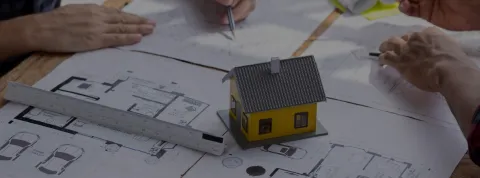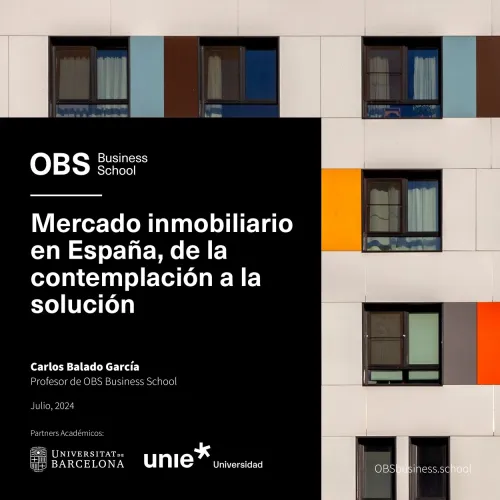
OBS Report: Real Estate Market in Spain 2024
Legal changes and lack of legal certainty lead to the progressive withdrawal of rental properties
- The gap between supply and demand will intensify over the next 20 years due to more expensive financing, scarcity of land in large cities, lack of skilled labor and a general increase in the price of materials.
- Sales and purchases fall especially in Navarra, the Balearic Islands and Aragón. They increase in La Rioja, Asturias and the Basque Country.
- Housing prices have increased by 3.3%, with Barcelona, Madrid, and San Sebastián being the most expensive cities. For the third consecutive year, Malaga has seen the highest growth in new housing prices among Spanish capitals. Meanwhile, the number of mortgages has declined by 18.8%.
- The effort rate soars in the Balearic Islands to 58.6%. Zaragoza is the province with the lowest rate of effort (32%) when it comes to paying for housing.
- Spain ranks at the bottom in Europe, dedicating just 2.5% of its housing stock to official protection or affordable housing.
August 2024. OBS Business School, part of Planeta Formación y Universidades, releases the report Real Estate Market in Spain, directed by Professor Carlos Balado. The report analyzes the causes of the longstanding imbalance in the Spanish real estate market and proposes necessary measures to address it.
The past decade has highlighted the imbalance between housing supply and demand in Spain, a trend that could worsen over the next 20 years if new housing construction continues at its current rate of 80,000 to 100,000 units per year. This rate is insufficient to meet the projected demand of around 200,000 new households annually. The OBS report suggests that increasing the supply to reasonable levels could take 10 to 20 years, requiring a fourfold increase in the current construction rate. However, small developers face challenges such as higher financing costs, a shortage of land in major cities, a lack of skilled labor, and rising material prices. Temporary partial solutions are necessary, including rental deductions for specific groups, incentives for savings towards home purchases, regulatory changes to facilitate rental housing availability, and government promotion of social rental housing construction. Carlos Balado, professor at OBS and director of Eurocofín, states: "Investment in land development should be countercyclical, supported and endorsed by both state and regional administrations. This policy would allow the development of land reserves, ensuring a surplus of land in management and transformation during various periods."
Essential figures
Home sales dropped by 13.7% in March this year compared to the same month last year. The largest declines occurred in Navarra (-13.6%), the Balearic Islands (-11.6%), and Aragón (-11.3%). Housing transactions increased only in La Rioja (5.6%), Asturias (4.3%), and the Basque Country (2.8%). By the end of the first quarter, prices had risen by 3.3% year-on-year, with the average price per square meter standing at €1,998. The highest prices were in Madrid (€3,344/m²), the Balearic Islands (€3,325/m²), the Basque Country (€3,031/m²), Catalonia (€2,463/m²), and the Canary Islands (€2,212/m²). The lowest prices were in Extremadura (€804/m²) and Castilla-La Mancha (€893/m²).
The number of mortgages fell again, with 46,410 operations recorded, representing an 18.8% decrease. The average mortgage in Spain stands at €141,912, with a monthly payment of €707. In the Balearic Islands, the average monthly payment is €1,284. Other provinces with high monthly payments include Madrid (€981), Malaga (€893), Barcelona (€868), and Guipuzcoa (€807). On the opposite end, the lowest monthly payments are found in Cuenca (€392), Lugo (€409), and Jaén (€413). Meanwhile, the number of buyers not requiring financing has increased by nearly 40%.
When buying or renting a home, buyers should not exceed a reasonable effort threshold of 35% of their salary. However, eleven Spanish provinces surpass this figure. The most stressed areas include the Balearic Islands, where the local population faces an effort rate of 58.6%, Barcelona at 51.9%, Malaga at 51%, and Madrid at 44.3%. In contrast, Zaragoza has the lowest stress rate at 32%.
Difficult access to housing
Spain needs to promote 1.2 million affordable rental housing units by 2030, but efforts are hindered by the slow rate of construction and the progressive withdrawal of housing due to legal changes and a lack of legal security. "There is a tendency in governments to confuse collaboration with interventionism, leading to the establishment of price control systems that reduce supply and have detrimental long-term effects", says Balado.
Planned investment for new affordable rental developments amounts to €108 billion (or €142,000 per unit), with 76% of this funding expected from private investment and only 24% from the public sector. Catalonia needs to build 225,000 affordable rental units over the next decade, requiring €1.01 billion. The Community of Madrid requires 174,000 new homes, necessitating €5.42 billion in public investment. Andalusia needs 85,000 units, with an investment of €4.53 billion, while the Valencian Community also requires 85,000 units, with an investment of €3.25 billion. The Canary Islands needs 46,000 units, with an investment of €2.49 billion
VPO (officially protected housing) reached its peak in 1985, accounting for 64% of all housing completions. However, figures began to decline in 2013, and by 2022, only 10% of housing was VPO. Today, Spain is among the lowest in Europe, dedicating just 2.5% of its housing stock to official protection or affordable housing.
Perspectives
For this year, sales are expected to continue their gradual decline. However, if interest rates decrease further and economic activity strengthens in the latter half of 2024, the real estate market may transition from the slowdown experienced in 2023 to a phase of expansion by 2025.
According to Sociedad de Tasación, the average price of new housing stands at €2,925 per square meter, reflecting a year-on-year increase of 4.1%. Prices exceed €4,000 per square meter in Barcelona, Madrid, and San Sebastián. For the third consecutive year, Malaga has seen the highest growth in new housing prices among Spanish capitals, with an increase of 7.2%. New housing prices are projected to rise by 4% in the third quarter of this year, while used housing prices are expected to increase by just over 1%. From October onwards, prices may stabilize or even decrease slightly.
In terms of financing, the OBS Report forecasts that the high cost of mortgages will continue, which will mean an increase of more than €550 per month for a new loan of €145,000 (average for mortgages in Spain). As a result, the stress rate will continue at 40%. Tensions in the real estate market will continue, especially in the rental segment, and in this context housing finance will be more cautious.
Content written by:
Carmen García-Trevijano
OBS Business School Press Office




